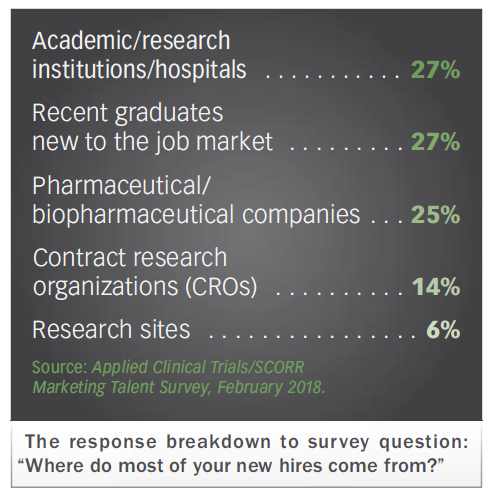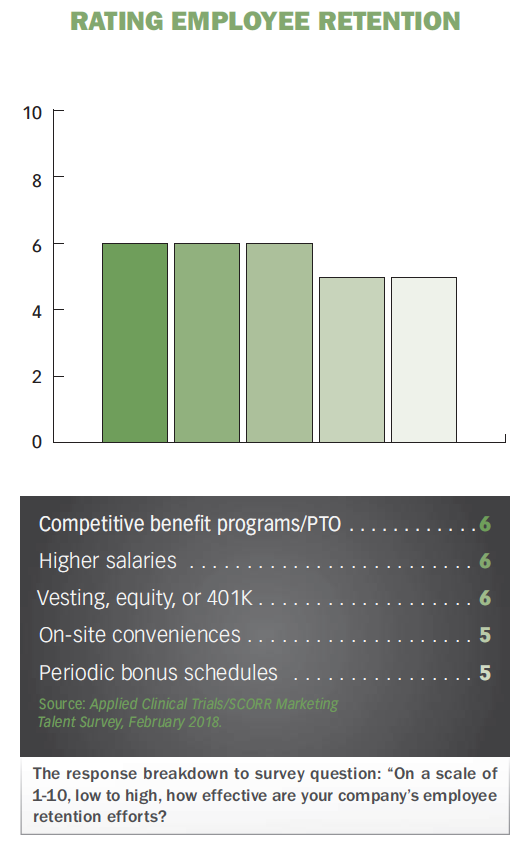Catch (& Keep) a Rising Star: Clinical Research Talent Trends
Applied Clinical Trials
Exploring the latest hiring and retention practices in the life sciences, where roles are changing fast. Impact trends from new talent survey are revealed.
Regardless if you are recruiting as a sponsor, contract research organization (CRO), or other, finding, training, and retaining your clinical research operations employees can be challenging. Bill Clemens, managing director with executive search firm Russell Reynolds Associates, says it helps to remember how the CRO industry has evolved. “What started over 30 years ago as a cottage industry is now a highly professional services industry.” He pointed to the big CROs-Quintiles, Parexel, PPD, Covance-whose founders have long since sold their businesses in IPOs or to private equity firms. “They’ve all made the transition to the next generation and businesses that can scale,” says Clemens.
He notes that now, unlike the CROs of yesterday, more people come into clinical research to make and shape their careers. “Much like pharma, when someone would start at J&J [for example] as a sales rep, then move up to manager, then marketing, and then into a higher position. People now enter CROs as CRAs (clinical research associates), then move up to project management and up from there,” he says.
Tim Neathery, vice president of talent acquisition for PPD, agrees: “More and more people are becoming aware of the positive aspects of building a career in the clinical research space, but with that has come a higher demand for those with certain types of experience. We try to strike a balance of hiring experienced clinical research professionals, while identifying those with the right competencies to be the best talent not only today, but also in the years to come.”
As Neathery notes, specific experience levels in clinical research are necessary for certain positions, but some roles are more flexible to the transferable skill set.

Transferable skills are fine also with Rho, a mid-sized CRO located in Chapel Hill, NC. Kay Lowery, Rho’s director of human resources, says the company evaluates prospective hires on overall skill sets, as well as potential. “Do they have project management skills or the fundamentals? Or do they have transferable skills that set the foundation for the jobs they are performing?” she says. “If they have relevant experience, then we can provide them with the tools and training to be successful in clinical research.”
In a recent Applied Clinical Trials/SCORR Marketing Talent Survey (view: http://www.appliedclinicaltrialsonline.com/talent-survey-march-2018), we covered many aspects of “talent” and the challenges faced by CROs, sponsors, sites, and academia on recruiting, retaining, and training that talent. One aspect is incentives. There are a number of programs companies offer to encourage potential candidates to either apply to or accept a position. Our survey found that 25% of respondents offer higher than above-average salaries and 16% offer new hire bonuses as financially-based incentives, but another 59% doesn’t use financial incentives at all. In the non-financial incentives category, flexible work hours and the ability to work remotely received 53% and 40%, respectively.
Other examples of making a workplace more desirable are employee engagement programs. In our survey, we asked what employee engagement programs were used in the respondents’ companies. The top answers were collaborative learning opportunities (42%), team-building events (35%), and continuous improvement feedback programs (27%). Examples of both non-financial incentives, as well as employee engagement programs, fall under what Lowery called work-life balance. “We believe that employees who have a good work-life balance are more productive,” she says. “By encouraging this balance and providing ways to help employees maintain a positive work-life routine, such as an on-site concierge service, Rho has found employees are able to focus more while at work and then be present in their personal lives, without having to worry about what is happening in the office.”
In our survey, we did not tackle the specific question of turnover; suffice to say that attention to recruiting, retaining, and training staff are generally positive outcomes for turnover. “Turnover in this industry across functions is around 21% in the US, and 18.7% ex-US,” says Judy Canavan, Managing Partner at HR+Survey Solutions, LLC, which conducts the annual CRO Global Compensation and Turnover Survey. “For CRAs, however, those turnover rates are higher. In the US, clinical monitoring alone is 25.8%, and outside the US, that rate is 22.9%.” Canavan attributes that to the fact that over the years, clinical trials have become increasingly globalized, so that turnover rate is shifting globally also.
Our survey did ask the open-ended question, “What is the most difficult position to fill in the life sciences industry?”-and our respondents noted therapeutic area experience, project managers, and CRAs. Lowery, Neathery, and Canavan confirmed that experienced CRAs are in high demand.
Canavan points out that the CRA job itself is demanding. Many work out of a home office and travel extensively to sites, which can lead to burnout. Another issue in the CRA area that the Association of Clinical Research Professionals (ACRP) and IACOR in Europe are trying to address is the perception that CRAs will only get hired if they have two years’ experience; but then there is no way to get that experience with the requirement. Those organizations are stressing competency over quantity.
Angela Roberts, head of CRA recruitment at craresources, a recruitment agency solely for CRAs, agrees that it is tough for hiring managers to find CRAs that have the right therapeutic experience, at the right time, at the right location, and with the right fit. That problem has created a groundswell of falsified resumes. In this article, http://www.clinical-cra.com/identifying-fake-cra-resume-part-1/, Roberts details the problem, with the result that her team has identified over 7,000 fake resumes, including about 21% of the CRA pool within their current database. “I asked a group of hiring managers recently if they did background checks and two-thirds admitted they don’t,” she says. According to Roberts, there are pockets of networks in the US that support each other by acting as false references, that will interview on a person’s behalf, and who create false companies with professional websites as well as presence on LinkedIn or Glassdoor. “My concern is that these people have no qualifications; their employer doesn’t know that but it will take at least six to nine months to discover they can’t do the job and get them out,” Roberts says. “But what happens to the patients or the trial?”

To develop strong skills among CRAs, PPD maintains two avenues for training high-potential individuals. In 2017, PPD launched an apprenticeship program targeted to military veterans and military service members with medical backgrounds who are transitioning to the civilian workforce. PPD also has its CRA Academy, launched in 2013 to help develop clinical research associates from within the company.
Both Neathery and Lowery believe that being a good employer goes a long way to recruiting and retaining talent. Neathery says, “At PPD, we ensure that career opportunities are available for current and future employees. We offer internal employee development programs and on-the-job experiences that help our staff prepare for their next role.”
Lowery says that Rho’s mentoring training, networking opportunities, and work-life balance offers them an edge in the difficult recruiting landscape. “I want to make sure that Rho stands out for potential candidates and they know about our great reputation,” says Lowery. Attracting candidates from the millennial generation is also on Lowery’s radar. “I think millennials get a bad rap,” she says. “They want to explore the world, have experiences, and make an impact. They have made employers rethink the way we should work and changed our beliefs on what’s important to employees, both of which have impacted how employers recruit.”
Now, and in the future, industry roles are changing. The remote site monitor role is one that Neathery notes has been developed in the past five years. And like other industries, Neathery says the ability to use technology, understand data, and translate that data into action will be more important for CROs. Neathery also says that individuals who can accept and embrace change and be flexible are well-suited to this changing landscape. Clemens adds, “At the end of the day, CROs is a tough business. It’s big, complicated professional services, with lots of moving pieces…the sites, the endpoints, process, data, the trials, all the outcomes that need to be measured. And they have to work it better than anyone else.”

Phase III Trial Finds Baricitinib Boosts Hair Regrowth in Adolescents With Severe Alopecia Areata
March 14th 2025The BRAVE-AA-PEDS trial found that once-daily baricitinib significantly improved hair regrowth on the scalp, eyebrows, and eyelashes in adolescents with severe alopecia areata after 36 weeks, with faster response rates compared to adults.
Behind the Buzz: Why Clinical Research Leaders Flock to SCOPE Summit
February 7th 2025In this episode, we meet with Micah Lieberman, Executive Conference Director for SCOPE Summit (Summit for Clinical Ops Executives) at Cambridge Innovation Institute. We will dive deep into the critical role of collaboration within the clinical research ecosystem. How do we bring together diverse stakeholders—sponsors, CROs, clinical trial tech innovators, suppliers, patients, sites, advocacy organizations, investors, and non-profits—to share best practices in trial design, program planning, innovation, and clinical operations? We’ll explore why it’s vital for thought leaders to step beyond their own organizations and learn from others, exchanging ideas that drive advancements in clinical research. Additionally, we’ll discuss the pivotal role of scientific conferences like SCOPE Summit in fostering these essential connections and collaborations, helping shape the future of clinical trials. Join us as we uncover how collective wisdom and cross-industry partnerships are transforming the landscape of clinical research.
Reaching Diverse Patient Populations With Personalized Treatment Methods
January 20th 2025Daejin Abidoye, head of solid tumors, oncology development, AbbVie, discusses a number of topics around diversity in clinical research including industry’s greatest challenges in reaching diverse patient populations, personalized treatment methods, recruitment strategies, and more.